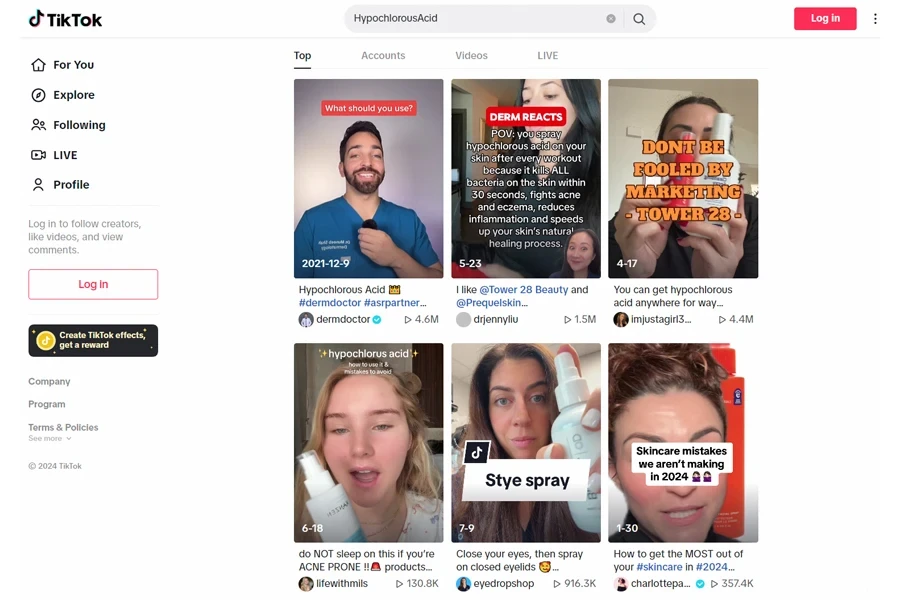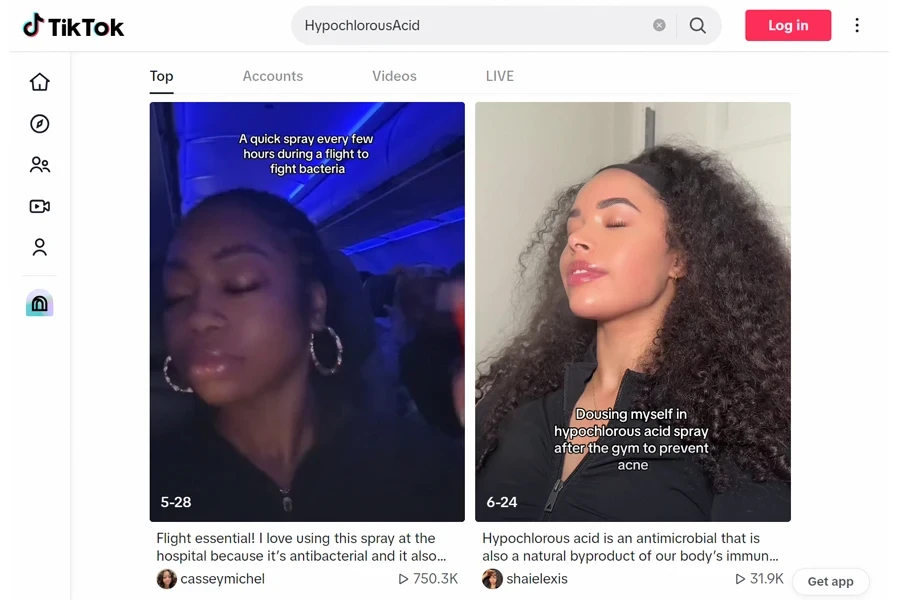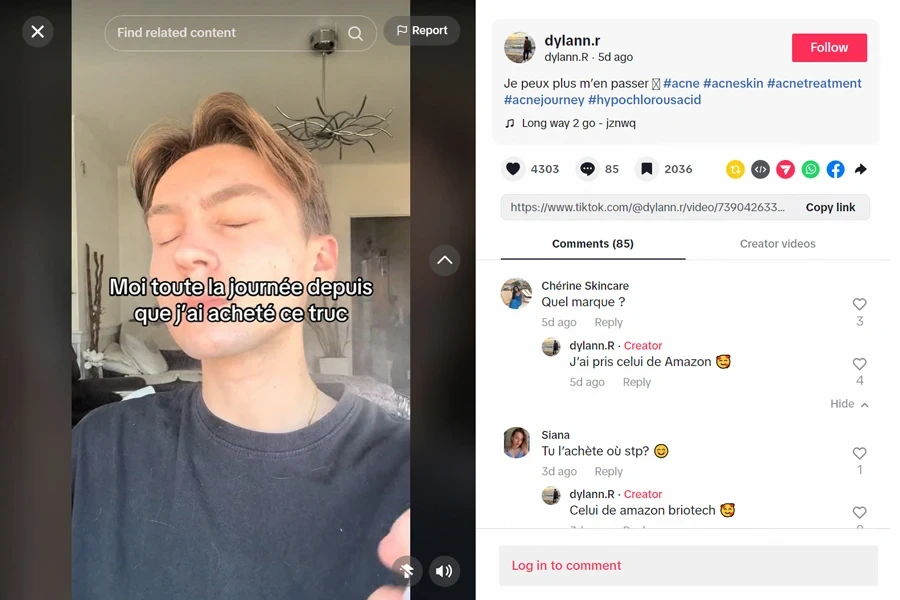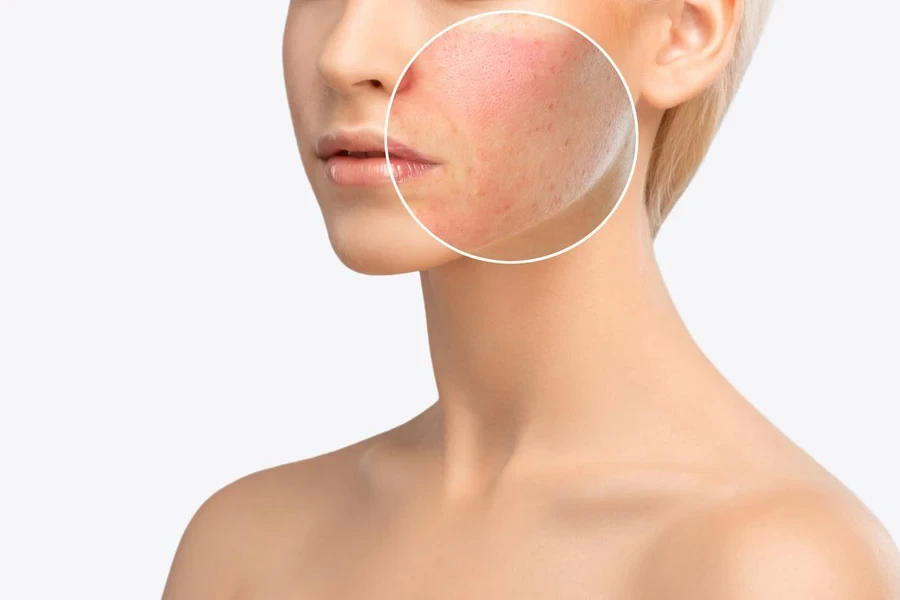TikTok’s beauty community has a new obsession, and it’s taking the skincare world by storm. Hypochlorous acid, once relegated to medical and industrial applications, is now emerging as a powerhouse ingredient in personal care. In this article, we’re diving deep into the trending #HypochlorousAcid phenomenon, and exploring its benefits, applications, and market potential.
Table of Contents
● What is hypochlorous acid?
● The TikTok hype: #HypochlorousAcid trend analysis
● Benefits and applications in skincare
● Product formats and innovations
● Market opportunities and future outlook
What is hypochlorous acid?
Hypochlorous acid (HOCl) is a weak acid with powerful oxidizing and antimicrobial properties. Naturally produced by white blood cells in the human body, it plays a crucial role in the immune system’s defense against pathogens. In skincare, this compound is gaining recognition for its ability to combat bacteria, reduce inflammation, and promote healing without causing irritation.
Traditionally used as a disinfectant in water treatment and medical applications, hypochlorous acid has found a new niche in the beauty industry. Its non-toxic and non-carcinogenic nature makes it a safe choice for various skincare applications.

The TikTok hype: #HypochlorousAcid trend analysis
#HypochlorousAcid has seen a significant surge in popularity on TikTok for its antibacterial and skin-healing properties. According to WGSN’s May-June TikTok Analytics, the trend shows a strong growth trajectory, with views increasing from around 1.4 million in July 2023 to 6 million by June 2024.
The ingredient’s impressive growth underscores the ongoing emphasis on hygienic skincare solutions. While traditionally used as a disinfectant, consumers are now leveraging its benefits to combat acne and other bacterial skin issues. By emphasizing ‘prejuvenation’ and longevity over the next two years, this ingredient is set to maintain its relevance as consumers increasingly seek proactive and reparative skin solutions.

Data Credit: Exolyt,TikTok worldwide data. Data for #HypochlorousAcid is compiled from the aggregation of TikTok hashtags: #hypochlorousacid and #hypochlorousacidspray.
The STEPIC* Index analysis reveals a good alignment with societal trends and a long projected lifespan for the hypochlorous acid trend. This suggests that the ingredient has the potential to become a staple in skincare routines rather than a passing fad.
Right now, the emerging trend #HypochlorousAcid is still in the skincare discovery phase, content under this tag is predominantly user-generated. People are raving about it as the go-to solution for minimizing breakouts after a workout, during flights, and outdoor activities. However, marketers may emphasize safety and focus on educating users in the short term, since overusing it can actually harm your skin. Looking ahead, there’s so much potential to tap into hypochlorous acid’s versatility for new product development, whether it’s for healing wounds or soothing irritation from head to toe.
STEPIC*: The STEPIC is an analytical model created by WGSN.com, encompassing the domains of Society, Technology, Environment, Politics, Industry, and Creativity. And the SEPIC index is an indicator created through qual and quant research on these topics.

Benefits and applications in skincare
Hypochlorous acid offers a range of benefits that appeal to various skin types and concerns:
- Antibacterial properties: Effective against a wide spectrum of bacteria, viruses, and fungi.
- Anti-inflammatory effects: Helps calm redness and irritation, making it suitable for sensitive skin conditions like rosacea and eczema.
- Wound healing: Accelerates skin repair processes.
- Moisturizing: Contrary to expectations for an antibacterial agent, it helps keep skin hydrated.
- Acne management: Its antimicrobial properties make it beneficial for acne-prone skin.
Dr. Marisa Garshick, a board-certified dermatologist, notes that hypochlorous acid “helps to repair the skin, it can be used to address various skin concerns, helping to calm redness and inflammation as well as skin sensitivity”.

Published within 5 days alone, this French micro-influencer got 87.6M views on this #hypochlorousacid video.
Product formats and innovations
Facial sprays and mists is the most popular format for hypochlorous acid in skincare. This application method aligns with its use as a quick, refreshing treatment, especially appealing to active consumers looking for post-workout skincare solutions.
Other emerging product categories include:
- Minimalist serums: Brands are formulating lightweight, water-based serums that deliver a concentrated dose of hypochlorous acid. These serums often combine hypochlorous acid with other soothing ingredients to create multi-functional products that address various skin concerns simultaneously.
- Cleansing wipes: Convenient for on-the-go use, hypochlorous acid-infused wipes are emerging as a popular format for gentle yet effective cleansing and disinfecting. These are particularly useful for travel, gym bags, or quick touch-ups throughout the day.
- Multi-functional products: Leveraging its versatility, brands like Magic Molecule (US) recommend their spray for various uses, from eczema treatment to sunburn relief.

Market opportunities and future outlook
The global hypochlorous acid market is set for substantial growth. Recent market research by SPHERICAL INSIGHTS, published in July, projects the market size to increase from USD 5.29 billion in 2023 to USD 7.81 billion by 2033, with a CAGR of 3.97%.
Key factors driving this growth include:
- Increasing demand for disinfection agents across various industries.
- Growing awareness of water quality and hygiene.
- Expansion in the food industry, where hypochlorous acid is used for sanitization.
- Advancements in wound management techniques.
- Expanding applications in veterinary care.
- Ongoing R&D activities exploring new uses for hypochlorous acid.
The North American market is expected to lead in terms of market share, driven by strict regulations, consumer preference for hygiene products, and adoption of advanced disinfection technologies. However, the Asia-Pacific region is predicted to show the fastest growth during the forecast period.
This projected market growth, coupled with the increasing popularity of hypochlorous acid used in skincare routine on TikTok, suggests a bright future for this versatile ingredient. As more consumers become aware of its benefits and as research continues to uncover new applications, we can expect to see hypochlorous acid featured in an even wider range of beauty and personal care products.
Conclusion
The rise of hypochlorous acid in skincare is a fascinating example of how an ingredient can transition from behind-the-scenes industrial use to the spotlight of beauty trends. Its growing popularity on TikTok, combined with promising market projections, suggests we’re looking at more than just a fleeting fad. This shift reflects a broader trend in the beauty world, where consumers are increasingly drawn to ingredients that pack a multifunctional punch and come with a solid scientific backing. As we’ve seen, the beauty industry is quick to innovate, and hypochlorous acid is no exception. From sprays to serums, it’s popping up in all sorts of skincare products. The journey of hypochlorous acid from labs to TikTok feeds gives us a glimpse into how science and consumer trends can come together, potentially shaping the future of skincare and personal care products.



